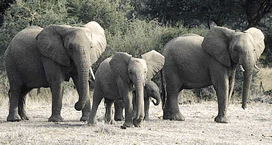You have no items in your shopping cart.
Human Elephant Conflict
 |
The Human Elephant ConflictElectric Fencing as a tool in the conflict |
A Holistic Assessment of the Human-Elephant Conflict.
On average, 800-1000 elephants die every year around the world due to intense human-elephant conflict. Any conservation strategy that has the potential to succeed must include efforts to bridge the gap between people and the wildlife with which they share their land, and through the participation and cooperation of the rural people whose lives it will invariably affect. This is clearly illustrated by third world farmers epitomised by those living in the Zambesi Valley Basin, Central Africa who have a particularly hard time trying to grow crops in the dry season. In addition to a lack of water, they have to deal with marauding animals that are looking for food. Elephants, hippo and buffalo routinely raid crops, trampling them in the process and ruining the harvest. This has forced farmers to abandon dry season farming and resort to illegal game hunting to provide food for their families.
Electric fences and other barriers to prevent movement of elephants onto arable land are increasingly important conservation tools in Africa, as elephant populations become isolated by areas of increasing human settlement. In attempts to reduce this many different types of elephant barriers have been built over the last 30 years. Of the deterrent strategies explored, only electrical fencing reduced elephant damage at the community level to satisfactory proportions

Wild Elephant in Botswana.
Constant high voltages (in excess of 6000volts) in electric fences will deter most elephants but low voltage, a frequent manifestation of poor maintenance, may merely irritate a determined elephant that may then destroy a section of the fence. Because each electric fence energier powers several kilometres of fencing, disruption of the power supply at one point inactivates a long section of fence. If power is not restored promptly the adverse conditioning associated with the barrier is lost, and long sections of the conflict boundary quickly become porous to elephants.
Illustrating this, fences similar to standard stock fences using high tensile wire were installed in the Omay Wildlife area, Northern Zimbabwe around 3 ha irrigation blocks producing green vegetable crops at the height of the dry season for consumption by the farmers family. These were severely tested by Elephants throughout the growing period but none entered. At the end of the crop the fields were abandoned and maintenance ceased, consequently Elephant and other animals breached the fence and severely damaged it. In each case, the fences reduced the number of raids by wildlife, and crop production increased. Families had vegetables to eat during the dry season, and as food production became more secure there was a striking reduction in illegal game poaching. At the same time, subsistence farmers were able to spend time on other income generating activities like poultry rearing, beekeeping and carpentry.

Wild Elephant behind an Electric Fence
With the increasing intensity of the conflict, the traditional methods of controlling elephant attacks may no longer be effective in most situations. Establishing a physical barrier - electric fencing - is considered as the most effective solution and during the last decade a substantial amount of money has been invested in this approach. Ad hoc decisions and improper planning which ignore the needs of stakeholders in the conflict should be avoided and all participants, human and wildlife, must be considered to achieve a holistic solution to a conflict situation. For example, in establishing the location of the fences, the elephants' breeding behaviour and migratory pattern should be considered in addition to the requirements of the local population.
The underlying assumption of fencing around parks is that wild elephants should live in designated areas (i.e. park areas). However, given their huge food and water requirements, (approx. 150 kg per day. Elephants eat 17 hours per day) migratory behaviour, long life spans, it is inevitable that free-ranging elephants raid crop fields. This indicates that the establishment of electric fencing should be linked with a comprehensive land use planning exercise where elephant habitats (i.e. park areas) should be grouped and interconnected via elephant corridors. The habitat should then be enriched and fenced. Therefore, electric fencing should not be seen as a medium-term solution but as an integral part of a long-term holistic solution package. It is certainly not a solution on its own.
Elephant are a problem escaping from Gona-re-Nzou National Park (Zimbabwe) to neighbouring farmland causing havoc with poor subsistence farmers. Despite using expensive, 18" thick poles and a mining cable fence, the huge animals simply pushed the poles over. An electrified 10 strand fence using 4" posts over 30 klm (18 miles) was substituted and the Elephant did not break through once. We had to lower the fence in one area as a herd of Zebra had got trapped on the wrong side, away from their water source. Still they would not cross and had to be driven over by helicopter.







